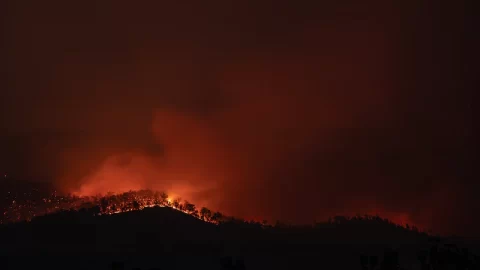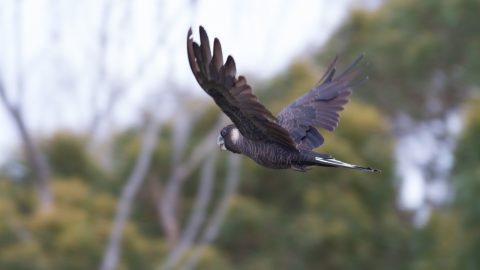In Fremantle, as I write, I hear the twittering of small birds, a gentle and constant sound that one would wish to go on forever. Earlier, as the blush of dawn lit up the big tree opposite, lively bird chatter broke out. By the afternoon, a kookaburra started its raucous laugh. Yet, when I finished drafting this article, it seemed to me I had not heard or seen black cockatoos in my part of Fremantle for some time, even though they can still be heard and seen at Murdoch University and in various parks around Fremantle, Melville and Cockburn. The morning after completing the article, I parked opposite a Cape Lilac tree in Blinco Street. It was full of forest red-tailed cockatoos, twenty-five in all, a mere three minutes’ drive from central Fremantle.
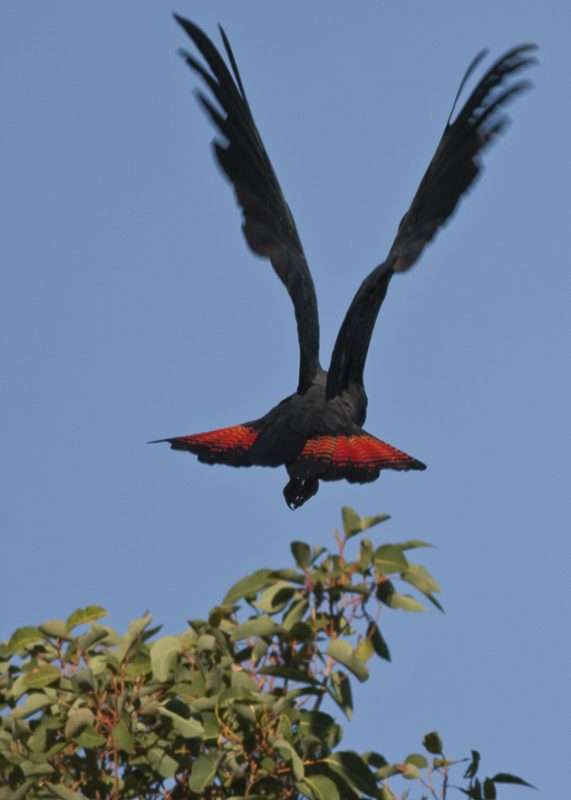
Red-tailed. Credit Jennifer Sumpton Photography
Before asking Kris Warren to talk about her recent project involving Carnaby’s cockatoos, I asked her about her research on the three black cockatoo species which are native to WA, all of which are officially listed as threatened species with the level of threat ranging from Vulnerable to Critically Endangered (the step before extinction). The forest red-tailed cockatoo, (or Karaks as Aboriginal people call them after their particular call) is listed as Vulnerable. The Carnaby’s cockatoo (the Ngoolark) is listed as Endangered and the Baudin’s cockatoo (Ngolak) is Critically Endangered. Both Carnaby’s and Baudin’s are black with white cheeks and some white feathers. Their upper beaks differ (resulting in different nibbling of gum nuts). The Carnaby’s bill is shorter than the Baudin’s (which has a more pointed tip) and there is a characteristic difference in calls. The Baudin’s cockatoo sends a whitcha, whitcha and the Carnaby’s a ‘weeoo wee-oo’ (BirdLife Australia).
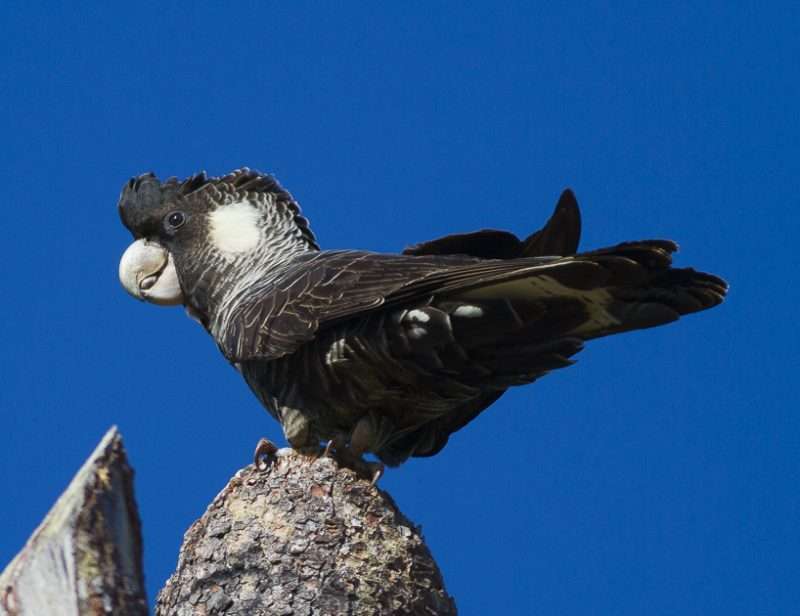
Carnaby’s. Credit Jennifer Sumpton Photography
The level of threat to the three species is confirmed by the International Union for Conservation of Nature’s Red List of Threatened Species. In Australia, the Baudin’s cockatoo is still listed as Endangered at State and Federal levels, perhaps due to slow administrative processes. As Kris adds, “the categories depend highly on the research that is done, as well as on the rate of decline. We know for example that we have smaller overall numbers of forest red-tailed cockatoos but factors such as the rate of decline are also considered in determining the categories.”

Baudin’s Cockatoo. Credit Jennifer Sumpton Photography
The key problem is that the black cockatoo’s natural habitat—mainly old growth trees with hollows—is constantly being reduced due to development and mining. As a consequence, many die when they forage or drink on the sides of roads. Another issue, with fatal consequences, concerns the way the black cockatoos have differently adapted to their loss of natural habitat.
Baudin’s cockatoos have adapted by feeding on fruit trees, particularly apple and pear trees, so the reason they are near extinction is because some orchardists shoot them (illegally) instead of using orchard netting, or other non-lethal scare mitigation measures. In 2016, WWF Australia estimated that approximately 200 Baudin’s cockatoos were injured or killed by being shot every year.
Carnaby’s have adapted to the drastic reduction in old growth forests by feeding on pine plantations, which are also in decline. The harvesting of the large Gnangara Pine Plantation in the north of Perth is a devastating loss for these birds who use these trees for both feeding and roosting. Finally, when the red-tailed cockatoos move into the suburbs for food, they are often attacked by ravens, which are quite territorial in their breeding season.
Jane Hammond’s excellent documentary Black Cockatoo Crisis, which showed these major problems, was partly informed by Kris’s research, and that of other researchers. Kris, who has been involved in black cockatoo research for fifteen years talked about her research and how it informs the latest project, Keep Carnaby’s Flying – Ngoolarks Forever, which is supported by $1.5 million Lotterywest Community funding. Keep Carnaby’s Flying, a title with a wonderful flying circus feel to it, involves drawing on previous scientific research to support large-scale community outreach and engagement projects in eight selected councils in the Perth-Peel region, over two years. In 2023, the councils include Melville and Cockburn councils, and Jarrahdale-Serpentine and Wanneroo councils, all strategically important to improving the survival of these birds in WA, including on the Swan Coastal Plain.
The wonderful thing about talking to people engaged in environmental and indigenous research is these discussions often lead you to reconfigure the way you think of yourself in space and time. So, sixty-five thousand years after our ancestors arrived here, we live by the ocean on the edge of the large Swan Coastal Plain where karaks, ngoolarks and ngolaks wheel and chatter. And when we all head to the beach for a dip this summer, the black cockatoos will all be looking to bring up their nestlings. It’s a perspective which lifts the heart.

CO: Kris, as I understand it your earlier research mainly focused on health and ecology issues in relation to Perth’s projected population expansion (3.5 million by 2050)?
KW: Yes, the research is ongoing in terms of smaller research projects. Initially it focussed on health then involved eight years in which we developed and used tracking to better understand flock movements, habitat use, and to identify critical feeding and breeding sites.
CO: We know that all three species are at risk of extinction, what do we know about their survival exactly? As I understand it, the black cockatoos are declining by up to 15% per year and could be extinct by 2029?
KW: In terms of differences in survival between the three species – Carnaby’s cockatoos have shown a 50-79% decline over the last 45 years and Baudin’s cockatoos a greater than 90% loss. And, of course, the problems for all species are exacerbated by climate change. Last summer was the hottest summer on record (it reached 47 degrees). We know heat events are hugely problematic. In 2010 over 150 Carnaby’s and Baudin’s cockatoos died in Hopetoun in the South-West from heat stress.
CO: What does historical information tell us about the previous existence of these birds?
KW: Well, before I answer more specifically, anecdotally I recall as a child in the 70s growing up near Murdoch and seeing thousands of black cockatoos – the sky turning black with cockatoos. There could be 6-7000 birds in one flock (recorded at the time) in the Murdoch area due to the UWA pine plantations, which are now gone. I still live in the area and I’m excited if I see a couple of hundred birds in a flock. In 1969 research work was started by Denis Saunders, ex-CSIRO, to protect the Carnaby’s which were then legally-termed vermin and had a bounty on their heads. It was he who recorded the huge size of some of these flocks. Our research has continued from his important early work by using his research site at Coomallo Creek (as well as other sites) as a benchmark for our health research on the Carnaby’s cockatoo in particular.
CO: So, Kris, what factors inform the formation of a flock?
KW: Well, it’s complicated! Depends if it is breeding or non-breeding season, depends on the species and on location and food availability. In general, flocks are made up of many family groups. A number of Carnaby flocks will gather at a roosting site at night but will break up into smaller flocks to forage in the day. We have also tracked a mix of Baudin’s and Carnaby’s that roosted together at night, with each species foraging separately in the day. Red-tailed are an exception, they have smaller flocks in general and are not migratory in terms of breeding, but move between the plain and forested areas. This can be a 40-50 kilometres range. Red-tailed cockatoos tend to have smaller flock sizes too. Tracking them showed us, for the first time, that they can move over far wider distances than previously thought, travelling for 70-80 kilometres through forest blocks over time. But they tend to spend more time foraging (hopping along between trees) and less time flying, so they have less energy requirements. Baudin’s and Carnaby’s, in contrast, spend more time flying, using more energy.
CO: I understand all three species only have one chick? This must put a lot of pressure on their survival?
KW: Understanding their breeding is an important issue. The Carnaby’s for instance, stay together for life, they lay two eggs but usually only one is reared (unless plenty of food is available). The tendency is for the single chick to stay with its parents for eighteen months. We know of situations where the female has died, and the surviving male will raise the chick. Our concern is not just for the security of their roosting sites, but concerns the distance each species must travel to access food and water.
CO: I understand Murdoch University developed the special tracking system which has produced most of what we now know. Can you tell us more about how it works?
KW: We developed a double-tag methodology and trialled it successfully (first in aviaries then in the bush) in 2009. Many people thought it would be impossible to tag Carnaby’s, in particular, as they are very curious birds and, with their big beaks, they might easily remove tags. But that has not proved to be the case. One of the tags is a solar-powered GPS tag which we attach to four feathers on the bird’s back (eventually they can pull it off).The second one is the Argos satellite tag used for location; this is attached to central tail feathers. All the birds tolerate this tag very well and it generally stays on until the next moulting cycle. Carnaby’s cockatoos tend to have a post-breeding annual moult, so they can be tracked for about 11 months. A forest red-tailed cockatoo actually kept one of these tags on for a record 408 days. A gold star for that one!
The tags are attached under anaesthesia; it’s about a 45-minute procedure for each bird. We attach them either to birds that have been injured and are being rehabilitated at Kaarakin Black Cockatoo Conservation Centre, or we attach them to adults at breeding sites. Although the process is costly, the GPS tags are collecting data every 2.5 to 10 minutes, an enormous amount of data. For the GPS tag we need to be out where the birds are, so we can collect data using antenna. Some birds have GPS tags on for over four months so we have been able to pick up the full migratory movement away from breeding grounds. The Argos satellite tags download less often but report locations direct to the computer.
Each tagged bird is, of course, indicative of the behaviour of its entire flock. We can find out from the fieldwork the size of the flock, what they are eating, and their flight path. Because of the tags we can also tell, when we release rehabilitated birds back into a flock, that it generally takes up to a week to fully integrate into the flock.
The Perth-Peel region is important to all these birds in the non-breeding season. We know, for example, that the birds congregate in the Gnangara pines prior to departing for their breeding sites. In the breeding season (winter and spring) they head off to the east and north to the wheat belt. Our tracking system also shows some cockatoos moving to the southern parts of the Swan Coastal Plain to breed. We have learnt about these movement pathways and identified breeding sites through tracking them. All three species are looking for old growth forests with hollows to nest in.
CO: The new project, you and your collaborators (including wildlife vets, ecologists, community and Aboriginal organisations) have begun, focusses on working with local government and individuals to ensure the survival of the Carnaby’s cockatoo in particular (with knock-on benefits to the other two species). You describe the Carnaby’s cockatoo as a flagship species. What does that mean exactly?

KW: The Carnaby’s are a flagship species in that they are well-known across the Perth-Peel region and are endangered. In this sense, individuals and communities are familiar with the birds and concerned for their plight. The birds are frequently out on the plain in summer and autumn each year where they are seen flying gracefully in large numbers. People recognise them—hear them, in fact, before they see them—so that many people care about them. In many ways they are a defining feature of what it is to live in and around the Perth-Peel region.
CO: What particular issues came from the tracking research?
KW: We have been able to track birds from Chapman Valley in the North to Esperance in the South. We know that both Carnaby’s and Baudin’s have a migratory breeding movement and they will utilise the same resources in the landscape when they move through particular areas. We also know that Carnaby’s fly between 4-6 kms to forage from their roost site. So, we are working with councils to ensure they have food within that distance – which is less for the red-tailed cockatoos.
CO: What work are you doing with the councils nearest to Fremantle: the Melville and Cockburn councils?
KW: The support from Lotterywest is being used to create a Conservation Action Plan for each local council, and each is underpinned by our tracking research. The tracking research identifies critical roosting, foraging and breeding habitat at landscape scale. So, for councils we are able to identify where the key roosts are and identify sites where it would be good to undertake revegetation and in-fill planting activity. That might be native vegetation planting in remnant bush land or it could be planting in open space around public ovals. By involving councils and individuals in protecting this species we are able to put in place vegetation corridors and replanting programs which will benefit other black cockatoo species that might inhabit the same area.
Our research shows the importance of vegetation corridors, even small patches of vegetation, which is why we work with councils as well as providing information to individuals. We need to provide corridors to facilitate their movement across the area, as well as water to encourage their movement and hydration. It is very important to provide suitably-located water stations and to plant hakeas, banksias, marri and jarrah, and other suitable food plants.
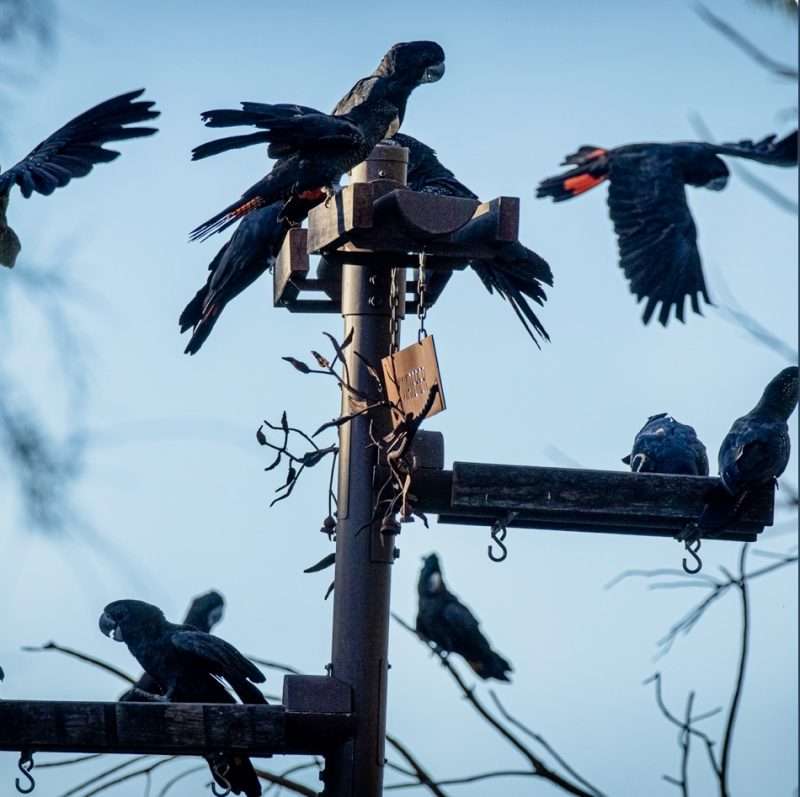
Cockitrough. Credit Town of Victoria Park
We also provide a Cockitrough, a water drinking station designed by the Town of Victoria Park, to councils to replicate across their regions. We provide the Cockitrough as an example to the council we work with and we map which locations would be good for installation of such water drinking stations in relation to roost sites. The Cockitrough is four metres high and is fed by the mains so it is very effective in preventing the birds using water on the ground (that might be contaminated by pesticides) or drinking out of pot-holes on the roads or getting under sprinklers that are watering the roads (all of which put the birds at risk of road death). The troughs are particularly important as we head into another hot summer.
CO: The planting of verges is very popular in Fremantle, is this the right thing to do?
KW: In general, yes, of course. However, there are risks to the birds from vehicle strike when foraging near roads. So, if food plant species, such as ground cover banksias, are planted on verges then it is important that these are appropriately set-back to help prevent vehicle strike. We generally advise that in quiet suburban streets, where the speed limit is 50 km/hr or less, to plant food plant species at least 3-5m back from road verges. For busy roads with speed limits over 50 km/hr, plant at least 10m back from the road verge. Of course, planting any food enjoyed by the birds in median strips is a death trap for the cockatoos. Food plant species should never be planted in median strips.
For all the Fremantle residents who wish to support the black cockatoos, do go to our website Keep Carnaby’s Flying – Ngoolarks Forever, which has many great ideas as to what to plant and how to get involved.
CO: Thanks Kris. When it gets too hot for you out at Murdoch this summer, do come down to Freo for a dip!
* By Dr Christine Owen
WHILE YOU’RE HERE –
PLEASE HELP US TO GROW FREMANTLE SHIPPING NEWS
FSN is a reader-supported, volunteer-assisted online magazine all about Fremantle. Thanks for helping to keep FSN keeping on!
** Don’t forget to SUBSCRIBE to receive your free copy of The Weekly Edition of the Shipping News each Friday!



